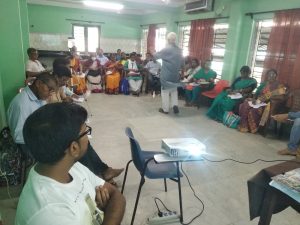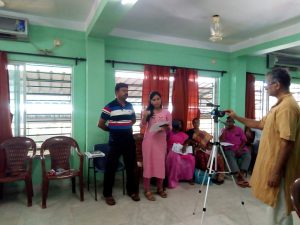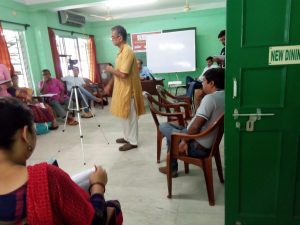

Mukti Participated in a Workshop on “Swaraj Village”
On 26th and 27th June 2022 Mukti participated in a workshop at Sebakendra, Kolkata organized by “Association for India’s Development” (AID). The subject of the workshop is “Bhalo Somaj Aajker Gram Swaraj” (A good society can form a swaraj village). 26-30 members of 14 NGOs from different parts of West Bengal have gathered to attend the workshop. On behalf of Mukti Mr. Harisadhan Mondal, Ms. Amuna and Ms. Nandita Jayraman participated in the workshop. On behalf of AID Mr. Somnath Mukherjee and Mr. Partha Dey have been present. The workshop has been conducted by Mr. Satyajit.

On the first day of the workshop, the participants have been provided knowledge on how to create a better society by forming a well-organized village assembly- Swaraj. In order to give a complete idea about this, the stories of 4 indigenous villages in 4 countries of the world are mentioned where the village assembly (gram sabha) – created by the villagers authorizes the villagers’ activities.
Kibbutz villages of Israel – Kibbutz are a collective community, traditionally agrarian. Even today, out of about 240 Kibbutz, 60 hold the old ideal socialist principle “mantra”. The principle is that everyone will give to society according to their power, and they will get from society according to their real needs. There is no personal or hereditary property in this village. Everyone gets equal allowance in terms of work or time. Food for the whole village is cooked in one communal kitchen where besides eating together they can discuss various issues and can strengthen social bonds. Raising children is not only the responsibility of his parents but also the responsibility of the whole village. There is no discrimination of work between men and women – even women are allowed to do the laborious job. All decisions are made in the general meeting with all the members including monetary issues. In particular, since the 1990s, resisting dynamic marketing, the blows of individualism, has allowed 60 kibbutzes to re-establish their old socialist ideology.

Zapatista indigenous movement – On 1 January 1994, the Zapatista Army of National Liberation (EZLN), an indigenous armed organization, declared war on the Mexican Government, demanding “work, land, housing, food, health, education, independence, liberty, democracy, justice and peace.” Over a long period of 25 years, with 1000 villages, 29 cities and 3.5 lakh people involved this movement has taken the shape of a full-fledged civilization. The revolutionary women’s law has been created to demand equal rights for women. They have also worked to create gender equality. There are three village government agencies for village management where everyone over the age of 12 can participate. The village has a three-tier government and an education system where Spanish is taught as well as indigenous languages. Government employees and education workers involved in education do not receive any salary. The villagers meet all their needs. There is a health worker in every village who is trained regularly to improve their skills. Products are produced and sold on a cooperative basis. The Zapatistas used some slogans to convey their main ideas and principles which are now popular all over the world such as – Ya Basta, A world where many worlds fit, and Asking while walking. Many people from all around the world visit this village to visualize the impact of this world-famous movement.
Amish aboriginal community of America – Indigenous Amish people living in America tend to live a very primitive way of life, abandoning consumerism and self-centeredness. They do not use modern technology machinery. After all, they do not exploit nature. They first verify everything about modern civilization. They reject the thing which drives them away from one another. The lowest abuse in their society is “hakmut” meaning arrogant.

Mondalekha – today’s village Swaraj – There is no elected government in this village. Village meetings are held every month. All decisions are unanimous. No minister, government official, NGO, professor or even outsider can come to the village and discuss any issue without the permission of the village council. How the money of the government scheme will be spent is still decided at the village meeting. Under the Forest Rights Act 2006, this is the first village in India to get collective forest rights. If anyone in the village wants to learn something, they start a “discussion cycle” but only the village council has the right to decide. Gram Sabha/council forms executive committee as required. In 2014, this village has been included in the “Gramdan Act”. According to this law, there will be no private land in the village, all the land is under the jurisdiction of the village or gram sabha/council. Since 2018, work has started to form grand gram sabhas/councils with 119 gram sabhas in two blocks.
On the second day, the discussion is on how an ideal gram can be formed.
- The village will be a joint family.
- There will be rural socialism in the village i.e. no one will have any personal wealth.
- All income will be deposited in the village cell.
- Every family will get an equal share of production.
- Cooking will be in the communal kitchen.
- All decisions will be taken by everyone in the gram sabha, that is, participatory democracy.
- Who will do what will be decided in the village meeting; there will be no such thing as unemployment.
- A separate committee will be formed as required and the trade will be done jointly.
- Children are the responsibility of the entire village.
- The village will have its own education system which will be symmetrical with the ideals of a good village.
- Through constant discussion, the villagers will decide what it means to be a good village, good people, good people.
- They will continue to try to correct the faults of their own society through internal Satyagraha.
- While rejecting nationalism, the village council has to provide food, shelter etc. for the villagers.
- In Gandhiji’s language, it is necessary to create an equatorial marine circle.
Project Activities
- A village for independent and enterprising women (A VIEW) (5)
- About Mukti (4)
- Accreditation (14)
- AGM (63)
- Agriculture Reforms (123)
- Ambulance Service (2)
- Amplifying Community Voices (66)
- Awards (14)
- Awareness and Empowerment (130)
- Awareness drives (54)
- Bio-Village-Kankandighi (10)
- Careers (14)
- Chick Rearing Programme for Marginalised Women (16)
- CHILD (17)
- Climate Resilience River Embankment (46)
- Covid-19 (74)
- Cultural Shows (7)
- Cyclone Aila (13)
- Cyclone Amphan (44)
- Cyclone Bulbul (30)
- Cyclone Dana (3)
- Cyclone Remal (12)
- Cyclone Response & Recovery (90)
- Cyclone Tolerant Houses (15)
- Cyclone Yaas (57)
- Disaster Recovery (264)
- Editorial (54)
- Editorial by Abir Biswas (1)
- Editorial by Amit Kumar Dey (2)
- Editorial by Ananya Chatterjee (3)
- Editorial by Ankita Kothiyal (3)
- Editorial by Debabrata Halder (1)
- Editorial by Dr. Alokananda Ghosh Sengupta (2)
- Editorial by Kasturi Bakshi (1)
- Editorial by Monami Mitra (1)
- Editorial by Nandita (3)
- Editorial by Pampa Karmakar (1)
- Editorial by Pranay Patra (1)
- Editorial by Prof. Pradeep Ray (1)
- Editorial by Ranitendranath Tagore (1)
- Editorial by Sankar Halder (14)
- Editorial by Satyajit Ray (7)
- Editorial by Sohini Mehta (1)
- Editorial by Sonamon Basu (3)
- Editorial by Soumitra Bose (1)
- Editorial by Subhankar Basu (1)
- Editorial by Supriyo Banerjee (3)
- Editorial by Ujjwal Maity (2)
- Education and Enrichment (405)
- Environment and Resilience (127)
- Featured Activities (21)
- Gram Clinic (9)
- Health Water & Sanitation (95)
- HOPE (10)
- Impact Stories List (109)
- Integrated Development (209)
- International Management Institute (IMI) (2)
- Jal hi Kal (6)
- Kitchen Gardening (16)
- Livelihood & Enablement (218)
- MCDF (119)
- Medical Camp (44)
- MIT (8)
- MKSS (48)
- MSS (140)
- Mukti Academia (5)
- Mukti Academy (2)
- Mukti Craft (17)
- Mukti Cultural (2)
- Mukti Employment Exchange (MEE) (9)
- Mukti Fresh (15)
- Mukti Gram - Egra (11)
- Mukti Gram - Purbashridharpur (170)
- Mukti Green Defense in Sundarbans (11)
- Mukti Yoga (12)
- Mukto Dhara (2)
- Northumbria University (2)
- Obituary (6)
- Observance Days Celebration (53)
- Organic Farming & Training Support (45)
- Pond Rejuvenation (20)
- Prerana (1)
- Prerna (4)
- Projects For Mukti Wide (7)
- Queen Mary University of London (1)
- Rights and Special Needs (112)
- Run for Cause (13)
- Run4SafeFood (7)
- SDF (6)
- Shahoshini (9)
- Skill & Enterprise Development (21)
- Smart lab (5)
- Social Stock Exchange (2)
- Social Workers' Convention (1)
- Sundarbans Green (SUN-G) (15)
- Sunderban development fair project (4)
- Surya (12)
- Sustainable Agriculture Movement (62)
- SWAS-2-0 (18)
- Swastha Shongini (32)
- Swavalamban Accelerator in Sundarbans (SWAS) (21)
- Tour for Cause (45)
- TSS (194)
- UDAAN (7)
- Uncategorized (99)
- University of Calcutta (1)
- Value Education (12)
- Valued Partners (3)
- Vocational Trainings (15)
- VOICE (14)